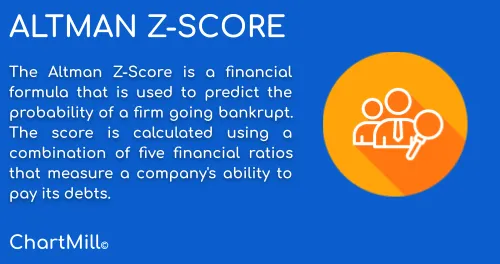What is the Altman Z-score?
By Kristoff De Turck - reviewed by Aldwin Keppens
Last update: Apr 19, 2024
The Altman Z-Score is a financial formula that is used to predict the probability of a firm going bankrupt. It was developed by Edward I. Altman, who was a professor at the NYU Stern School of Business.
The score is calculated using a combination of five financial ratios that measure a company's ability to pay its debts. These ratios are:
- working capital/total assets,
- retained earnings/total assets,
- earnings before interest and taxes/total assets,
- market value of equity/total liabilities,
- sales/total assets.
The resulting score is then placed on a scale from 0 to 100, with a score of less than 1.8 indicating a high probability of bankruptcy and a score of greater than 3.0 indicating a low probability of bankruptcy.
Calculating the Altman Z-Score
Z-Score = 1.2 * (working capital/total assets) + 1.4 * (retained earnings/total assets) + 3.3 * (earnings before interest and taxes/total assets) + 0.6 * (market value of equity/total liabilities) + 1.0 * (sales/total assets)
To use the Altman Z-Score calculator formula, you will need to gather the following financial information for the company you are evaluating:
- Working capital: This is the difference between a company's current assets and its current liabilities. It can be calculated by subtracting the company's current liabilities from its current assets.
- Total assets: This is the total value of all of the company's assets, including cash, investments, property, and equipment.
- Retained earnings: This is the portion of a company's profits that are kept by the company rather than being distributed to shareholders. It can be found on the company's balance sheet.
- Earnings before interest and taxes (EBIT): This is a measure of a company's profitability that excludes the effects of taxes and interest payments. It can be found on the company's income statement.
- Market value of equity: This is the total value of a company's outstanding shares of stock. It can be calculated by multiplying the number of outstanding shares by the current market price per share.
- Total liabilities: This is the total amount of money that a company owes to its creditors. It can be found on the company's balance sheet.
- Sales: This is the total amount of money that a company has generated from the sale of its goods or services. It can be found on the company's income statement.
Once you have gathered all of this information, you can plug the numbers into the formula to calculate the company's Altman Z-Score. Again, a score of less than 1.8 indicates a high probability of bankruptcy, while a score of greater than 3.0 indicates a low probability of bankruptcy.
Is the Altman Z-Score reliable?
The Altman Z-Score is considered to be a reliable predictor of a company's likelihood of bankruptcy. It has been tested and used extensively in academic research and has been found to have a high degree of accuracy in predicting bankruptcy.
However, it is important to note that the Altman Z-Score is just one tool among many that can be used to assess a company's financial health. It should be used in conjunction with other financial analysis techniques, and any potential investments should be thoroughly researched and carefully considered before making a decision.
Can it be used in all Sectors and Industries?
The Altman Z-Score is designed to be applicable to companies in any sector or industry. It is based on a combination of financial ratios that are commonly used to evaluate a company's financial health, regardless of the industry in which it operates.
However, it is important to keep in mind that the formula for calculating the Altman Z-Score is based on the assumption that the company being evaluated is a manufacturing company. As such, companies in other industries may not fit the assumptions of the model perfectly and may not be evaluated as accurately by the Altman Z-Score.
For example, banks or similar financial institutions are less suitable to apply the Altman-Z model to. This is due to their specific core business where their liabilities (depositors) and assets (loans made) are always very high relative to their income.
In these cases, it may be necessary to modify the formula or use alternative methods of financial analysis.
Altman Z-Score in our screener
How to use this bankruptcy score as a screening filter and two sample screens can be found in this article.







